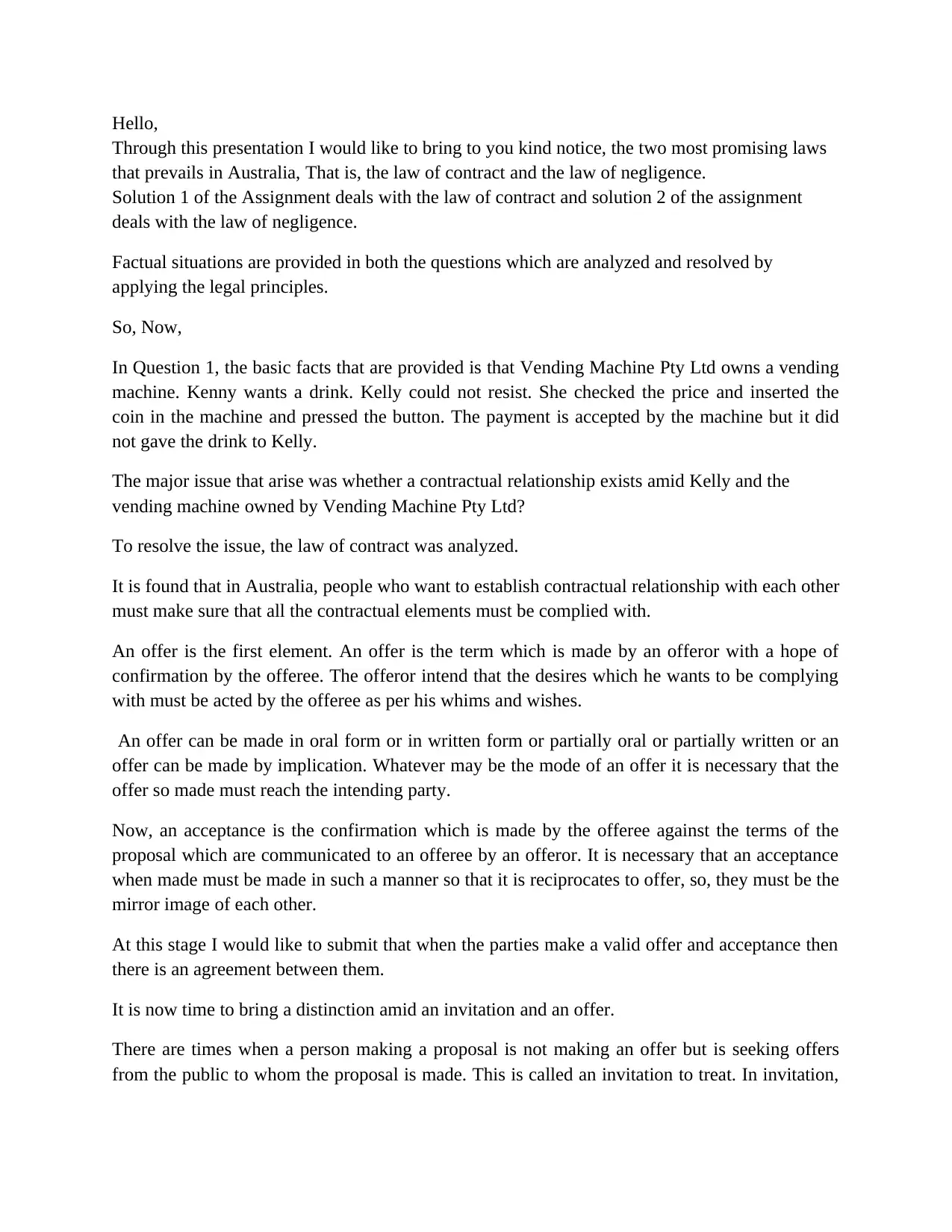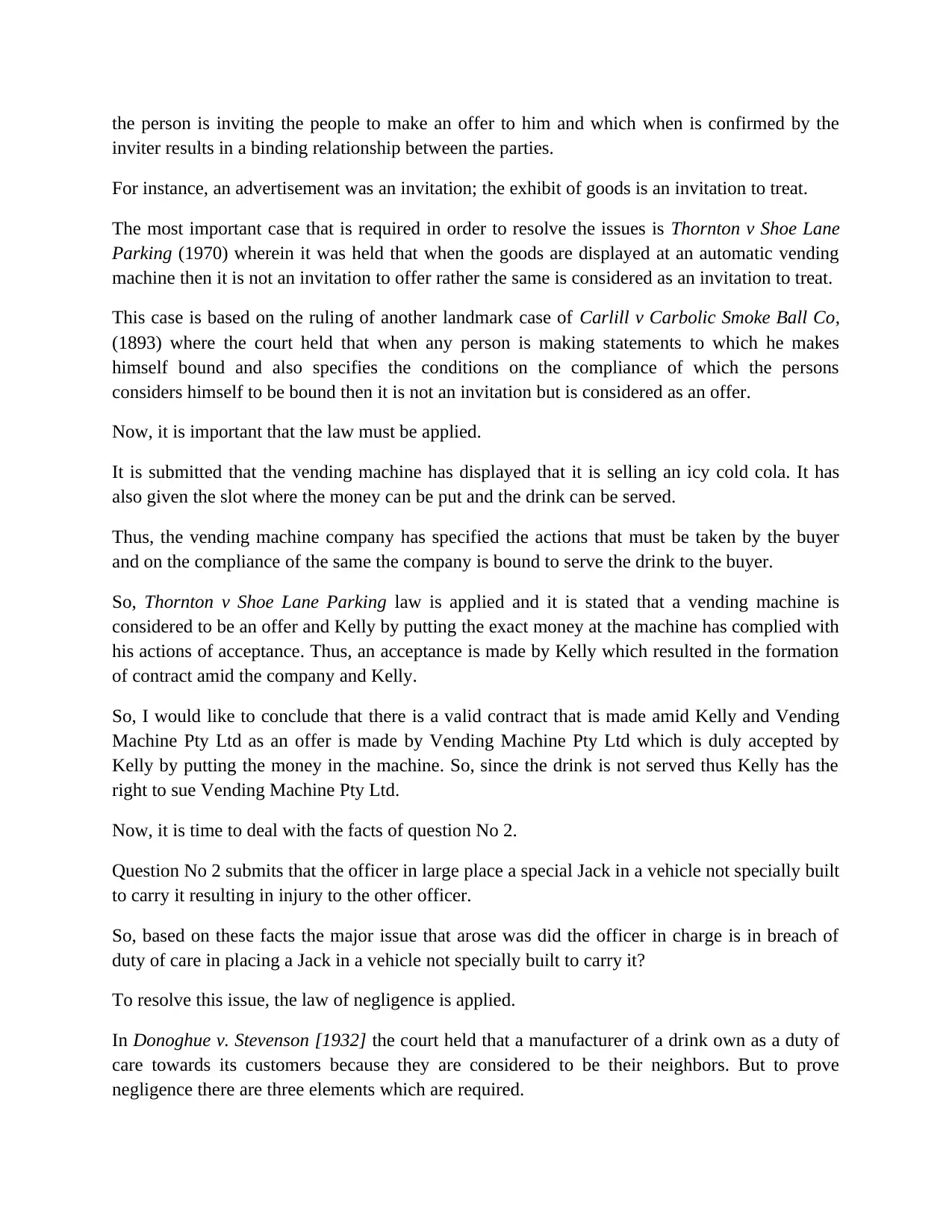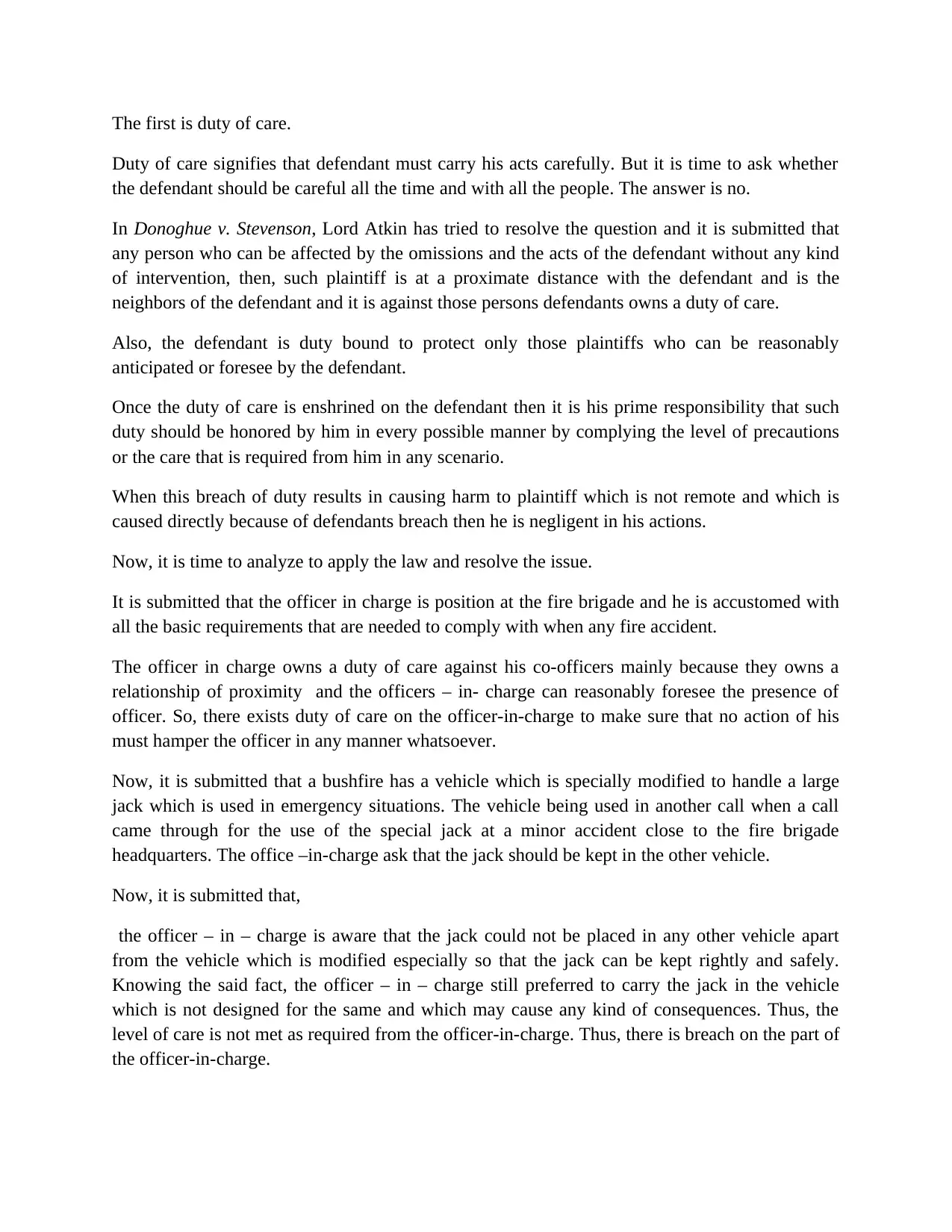Analysis of Contract Law and Negligence in Australian Context
VerifiedAdded on 2023/06/06
|4
|1584
|196
Case Study
AI Summary
This assignment presents a detailed legal analysis of two prominent laws in Australia: contract law and the law of negligence. It examines a scenario involving a vending machine transaction to determine if a contractual relationship exists, applying principles of offer, acceptance, and the distinction between offers and invitations to treat, referencing key cases like Thornton v Shoe Lane Parking and Carlill v Carbolic Smoke Ball Co. The analysis concludes that a valid contract was formed and Kelly has grounds to sue. Additionally, the assignment investigates a negligence case involving a fire brigade officer's injury due to improper placement of equipment in a vehicle. Applying the principles established in Donoghue v. Stevenson, the analysis determines whether the officer in charge breached their duty of care, ultimately concluding that the officer in charge is liable for the resulting injury due to their negligence.

Hello,
Through this presentation I would like to bring to you kind notice, the two most promising laws
that prevails in Australia, That is, the law of contract and the law of negligence.
Solution 1 of the Assignment deals with the law of contract and solution 2 of the assignment
deals with the law of negligence.
Factual situations are provided in both the questions which are analyzed and resolved by
applying the legal principles.
So, Now,
In Question 1, the basic facts that are provided is that Vending Machine Pty Ltd owns a vending
machine. Kenny wants a drink. Kelly could not resist. She checked the price and inserted the
coin in the machine and pressed the button. The payment is accepted by the machine but it did
not gave the drink to Kelly.
The major issue that arise was whether a contractual relationship exists amid Kelly and the
vending machine owned by Vending Machine Pty Ltd?
To resolve the issue, the law of contract was analyzed.
It is found that in Australia, people who want to establish contractual relationship with each other
must make sure that all the contractual elements must be complied with.
An offer is the first element. An offer is the term which is made by an offeror with a hope of
confirmation by the offeree. The offeror intend that the desires which he wants to be complying
with must be acted by the offeree as per his whims and wishes.
An offer can be made in oral form or in written form or partially oral or partially written or an
offer can be made by implication. Whatever may be the mode of an offer it is necessary that the
offer so made must reach the intending party.
Now, an acceptance is the confirmation which is made by the offeree against the terms of the
proposal which are communicated to an offeree by an offeror. It is necessary that an acceptance
when made must be made in such a manner so that it is reciprocates to offer, so, they must be the
mirror image of each other.
At this stage I would like to submit that when the parties make a valid offer and acceptance then
there is an agreement between them.
It is now time to bring a distinction amid an invitation and an offer.
There are times when a person making a proposal is not making an offer but is seeking offers
from the public to whom the proposal is made. This is called an invitation to treat. In invitation,
Through this presentation I would like to bring to you kind notice, the two most promising laws
that prevails in Australia, That is, the law of contract and the law of negligence.
Solution 1 of the Assignment deals with the law of contract and solution 2 of the assignment
deals with the law of negligence.
Factual situations are provided in both the questions which are analyzed and resolved by
applying the legal principles.
So, Now,
In Question 1, the basic facts that are provided is that Vending Machine Pty Ltd owns a vending
machine. Kenny wants a drink. Kelly could not resist. She checked the price and inserted the
coin in the machine and pressed the button. The payment is accepted by the machine but it did
not gave the drink to Kelly.
The major issue that arise was whether a contractual relationship exists amid Kelly and the
vending machine owned by Vending Machine Pty Ltd?
To resolve the issue, the law of contract was analyzed.
It is found that in Australia, people who want to establish contractual relationship with each other
must make sure that all the contractual elements must be complied with.
An offer is the first element. An offer is the term which is made by an offeror with a hope of
confirmation by the offeree. The offeror intend that the desires which he wants to be complying
with must be acted by the offeree as per his whims and wishes.
An offer can be made in oral form or in written form or partially oral or partially written or an
offer can be made by implication. Whatever may be the mode of an offer it is necessary that the
offer so made must reach the intending party.
Now, an acceptance is the confirmation which is made by the offeree against the terms of the
proposal which are communicated to an offeree by an offeror. It is necessary that an acceptance
when made must be made in such a manner so that it is reciprocates to offer, so, they must be the
mirror image of each other.
At this stage I would like to submit that when the parties make a valid offer and acceptance then
there is an agreement between them.
It is now time to bring a distinction amid an invitation and an offer.
There are times when a person making a proposal is not making an offer but is seeking offers
from the public to whom the proposal is made. This is called an invitation to treat. In invitation,
Paraphrase This Document
Need a fresh take? Get an instant paraphrase of this document with our AI Paraphraser

the person is inviting the people to make an offer to him and which when is confirmed by the
inviter results in a binding relationship between the parties.
For instance, an advertisement was an invitation; the exhibit of goods is an invitation to treat.
The most important case that is required in order to resolve the issues is Thornton v Shoe Lane
Parking (1970) wherein it was held that when the goods are displayed at an automatic vending
machine then it is not an invitation to offer rather the same is considered as an invitation to treat.
This case is based on the ruling of another landmark case of Carlill v Carbolic Smoke Ball Co,
(1893) where the court held that when any person is making statements to which he makes
himself bound and also specifies the conditions on the compliance of which the persons
considers himself to be bound then it is not an invitation but is considered as an offer.
Now, it is important that the law must be applied.
It is submitted that the vending machine has displayed that it is selling an icy cold cola. It has
also given the slot where the money can be put and the drink can be served.
Thus, the vending machine company has specified the actions that must be taken by the buyer
and on the compliance of the same the company is bound to serve the drink to the buyer.
So, Thornton v Shoe Lane Parking law is applied and it is stated that a vending machine is
considered to be an offer and Kelly by putting the exact money at the machine has complied with
his actions of acceptance. Thus, an acceptance is made by Kelly which resulted in the formation
of contract amid the company and Kelly.
So, I would like to conclude that there is a valid contract that is made amid Kelly and Vending
Machine Pty Ltd as an offer is made by Vending Machine Pty Ltd which is duly accepted by
Kelly by putting the money in the machine. So, since the drink is not served thus Kelly has the
right to sue Vending Machine Pty Ltd.
Now, it is time to deal with the facts of question No 2.
Question No 2 submits that the officer in large place a special Jack in a vehicle not specially built
to carry it resulting in injury to the other officer.
So, based on these facts the major issue that arose was did the officer in charge is in breach of
duty of care in placing a Jack in a vehicle not specially built to carry it?
To resolve this issue, the law of negligence is applied.
In Donoghue v. Stevenson [1932] the court held that a manufacturer of a drink own as a duty of
care towards its customers because they are considered to be their neighbors. But to prove
negligence there are three elements which are required.
inviter results in a binding relationship between the parties.
For instance, an advertisement was an invitation; the exhibit of goods is an invitation to treat.
The most important case that is required in order to resolve the issues is Thornton v Shoe Lane
Parking (1970) wherein it was held that when the goods are displayed at an automatic vending
machine then it is not an invitation to offer rather the same is considered as an invitation to treat.
This case is based on the ruling of another landmark case of Carlill v Carbolic Smoke Ball Co,
(1893) where the court held that when any person is making statements to which he makes
himself bound and also specifies the conditions on the compliance of which the persons
considers himself to be bound then it is not an invitation but is considered as an offer.
Now, it is important that the law must be applied.
It is submitted that the vending machine has displayed that it is selling an icy cold cola. It has
also given the slot where the money can be put and the drink can be served.
Thus, the vending machine company has specified the actions that must be taken by the buyer
and on the compliance of the same the company is bound to serve the drink to the buyer.
So, Thornton v Shoe Lane Parking law is applied and it is stated that a vending machine is
considered to be an offer and Kelly by putting the exact money at the machine has complied with
his actions of acceptance. Thus, an acceptance is made by Kelly which resulted in the formation
of contract amid the company and Kelly.
So, I would like to conclude that there is a valid contract that is made amid Kelly and Vending
Machine Pty Ltd as an offer is made by Vending Machine Pty Ltd which is duly accepted by
Kelly by putting the money in the machine. So, since the drink is not served thus Kelly has the
right to sue Vending Machine Pty Ltd.
Now, it is time to deal with the facts of question No 2.
Question No 2 submits that the officer in large place a special Jack in a vehicle not specially built
to carry it resulting in injury to the other officer.
So, based on these facts the major issue that arose was did the officer in charge is in breach of
duty of care in placing a Jack in a vehicle not specially built to carry it?
To resolve this issue, the law of negligence is applied.
In Donoghue v. Stevenson [1932] the court held that a manufacturer of a drink own as a duty of
care towards its customers because they are considered to be their neighbors. But to prove
negligence there are three elements which are required.

The first is duty of care.
Duty of care signifies that defendant must carry his acts carefully. But it is time to ask whether
the defendant should be careful all the time and with all the people. The answer is no.
In Donoghue v. Stevenson, Lord Atkin has tried to resolve the question and it is submitted that
any person who can be affected by the omissions and the acts of the defendant without any kind
of intervention, then, such plaintiff is at a proximate distance with the defendant and is the
neighbors of the defendant and it is against those persons defendants owns a duty of care.
Also, the defendant is duty bound to protect only those plaintiffs who can be reasonably
anticipated or foresee by the defendant.
Once the duty of care is enshrined on the defendant then it is his prime responsibility that such
duty should be honored by him in every possible manner by complying the level of precautions
or the care that is required from him in any scenario.
When this breach of duty results in causing harm to plaintiff which is not remote and which is
caused directly because of defendants breach then he is negligent in his actions.
Now, it is time to analyze to apply the law and resolve the issue.
It is submitted that the officer in charge is position at the fire brigade and he is accustomed with
all the basic requirements that are needed to comply with when any fire accident.
The officer in charge owns a duty of care against his co-officers mainly because they owns a
relationship of proximity and the officers – in- charge can reasonably foresee the presence of
officer. So, there exists duty of care on the officer-in-charge to make sure that no action of his
must hamper the officer in any manner whatsoever.
Now, it is submitted that a bushfire has a vehicle which is specially modified to handle a large
jack which is used in emergency situations. The vehicle being used in another call when a call
came through for the use of the special jack at a minor accident close to the fire brigade
headquarters. The office –in-charge ask that the jack should be kept in the other vehicle.
Now, it is submitted that,
the officer – in – charge is aware that the jack could not be placed in any other vehicle apart
from the vehicle which is modified especially so that the jack can be kept rightly and safely.
Knowing the said fact, the officer – in – charge still preferred to carry the jack in the vehicle
which is not designed for the same and which may cause any kind of consequences. Thus, the
level of care is not met as required from the officer-in-charge. Thus, there is breach on the part of
the officer-in-charge.
Duty of care signifies that defendant must carry his acts carefully. But it is time to ask whether
the defendant should be careful all the time and with all the people. The answer is no.
In Donoghue v. Stevenson, Lord Atkin has tried to resolve the question and it is submitted that
any person who can be affected by the omissions and the acts of the defendant without any kind
of intervention, then, such plaintiff is at a proximate distance with the defendant and is the
neighbors of the defendant and it is against those persons defendants owns a duty of care.
Also, the defendant is duty bound to protect only those plaintiffs who can be reasonably
anticipated or foresee by the defendant.
Once the duty of care is enshrined on the defendant then it is his prime responsibility that such
duty should be honored by him in every possible manner by complying the level of precautions
or the care that is required from him in any scenario.
When this breach of duty results in causing harm to plaintiff which is not remote and which is
caused directly because of defendants breach then he is negligent in his actions.
Now, it is time to analyze to apply the law and resolve the issue.
It is submitted that the officer in charge is position at the fire brigade and he is accustomed with
all the basic requirements that are needed to comply with when any fire accident.
The officer in charge owns a duty of care against his co-officers mainly because they owns a
relationship of proximity and the officers – in- charge can reasonably foresee the presence of
officer. So, there exists duty of care on the officer-in-charge to make sure that no action of his
must hamper the officer in any manner whatsoever.
Now, it is submitted that a bushfire has a vehicle which is specially modified to handle a large
jack which is used in emergency situations. The vehicle being used in another call when a call
came through for the use of the special jack at a minor accident close to the fire brigade
headquarters. The office –in-charge ask that the jack should be kept in the other vehicle.
Now, it is submitted that,
the officer – in – charge is aware that the jack could not be placed in any other vehicle apart
from the vehicle which is modified especially so that the jack can be kept rightly and safely.
Knowing the said fact, the officer – in – charge still preferred to carry the jack in the vehicle
which is not designed for the same and which may cause any kind of consequences. Thus, the
level of care is not met as required from the officer-in-charge. Thus, there is breach on the part of
the officer-in-charge.
⊘ This is a preview!⊘
Do you want full access?
Subscribe today to unlock all pages.

Trusted by 1+ million students worldwide

Now, on the way to the accident scene, the driver braked suddenly at the intersection and the
jack shifted injuring one fire officer. Thus, the loss to officer is caused by breach of the officer in
charge and the loss is also foreseeable.
So, at this stage it is rightful in concluding rat the officer-in-charge must be held liable for the
breach of the duty of care in placing a Jack in a vehicle not specially built to carry it.
jack shifted injuring one fire officer. Thus, the loss to officer is caused by breach of the officer in
charge and the loss is also foreseeable.
So, at this stage it is rightful in concluding rat the officer-in-charge must be held liable for the
breach of the duty of care in placing a Jack in a vehicle not specially built to carry it.
1 out of 4
Related Documents
Your All-in-One AI-Powered Toolkit for Academic Success.
+13062052269
info@desklib.com
Available 24*7 on WhatsApp / Email
![[object Object]](/_next/static/media/star-bottom.7253800d.svg)
Unlock your academic potential
Copyright © 2020–2025 A2Z Services. All Rights Reserved. Developed and managed by ZUCOL.



